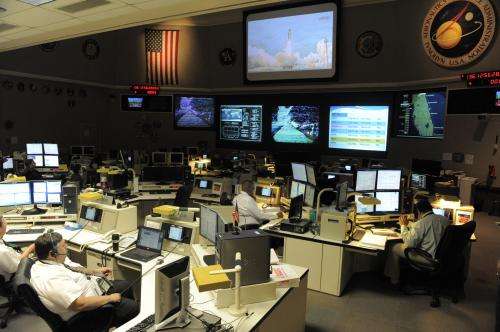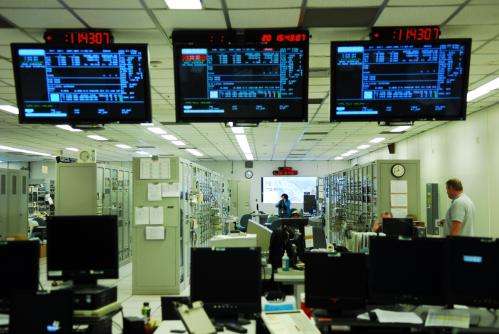During shuttle era, Goddard provided the critical path

From the time a space shuttle launched until it landed at the Kennedy Space Center, NASA's space communication networks provided the constant communication link necessary for every mission.
The Goddard Space Flight Center (GSFC) managed 'Integrated Network' combined NASA owned ground based antennas, the Near Earth Network (NEN); NASA's space based communications relay satellite network, the Space Network (SN); commercial communications services, and Air Force ground stations to provide crucial tracking, telemetry, and command services during space shuttle missions. The SN and NEN are funded and managed by NASA's Space Operations Mission Directorate, and the Space Communications and Navigation Program at NASA Headquarters.
"Every Human Space Flight mission from Mercury, Gemini and Apollo to the Space Shuttle and Space Station programs, has relied on the communications assets managed by Goddard," said Jeff Volosin, Deputy for Goddard's Exploration and Space Communications Projects Division. "Beginning at lift-off, any time an astronaut talked to mission control, whenever you saw video from the shuttle or the International Space Station, all system performance data received during flight, or when information was sent to the astronauts, it always traveled through Goddard's networks."
At launch, the shuttle team utilized the NEN ground-based antennas located near the Kennedy Space Center at the Merritt Island Launch Annex (MILA). That site, located about seven miles southwest of the launch pad, provided tracking, telemetry and command services for all shuttle missions.
MILA, a Goddard facility, utilized a plethora of antenna resources including two 9-meter (30-foot) S-Band dish antennas to fulfill its responsibilities. That location was critical to the flow of information between the shuttle and ground controllers. Two UHF antennas also provided voice communication with the orbiting astronauts.
However, MILA did not always have the line-of-sight to the launched vehicle. One minute into flight, the shuttle would begin rotating which obscured its antenna from the MILA site because of the highly reflective plume from the shuttle's solid rocket boosters. This 'plume impingement' during those crucial second and third minutes of flight necessitated a hand over of the communications links.

The Ponce De Leon Inlet Tracking Annex (PDL) located in New Smyrna Beach, Florida, 30 miles north of the Kennedy Space Center would accept the MILA hand off. A hand-over back would be completed a few minutes later as the shuttle antenna regained its line-of-sight with the MILA antennas. Together, MILA and PDL ensured uninterrupted communication with the shuttle during those first seven critical minutes after liftoff.
As the shuttle moved farther up the east coast the NEN ground station at Wallops Island (WPS), Va., would take the responsibility for providing command, telemetry, and tracking support. WPS also captured the video stream from cameras positioned on the shuttle's External Tank (ET) during separation from the orbiter. This data was crucial in determining if foam from the ET had been lost and possibly struck the orbiter during ascent.
Although ground based antennas at MILA, WPS, Dryden Flight Research Center, and Santiago, Chile, continued to play a supporting role once the shuttle reached orbit, the primary communication link was provided by the space based relay satellites of the Space Network (SN).
Approximately seven minutes into the flight a series of geosynchronous communication satellites acquired the communications support for the mission until about 30 minutes before landing. These Tracking and Data Relay Satellites (TDRS) are the core of NASA's space network.
An enormous amount of shuttle data is relayed through the TDRS to the SN communication hub in White Sands, New Mexico and onto mission control at Johnson Space Center in Houston, Texas. This critical data included voice and video communications, information about the orbit, stats on astronauts' health, and more. All of the command and control of an orbiting shuttle was sent through this same bent-pipe relay system.
As long as the shuttle orbited Earth, there was a continuous handoff of communication service provided by the prepositioned TDRS in view, much like the cell phone communication handoffs on earth. TDRS hand-offs occurred hundreds of times, ensuring a direct link to Earth, no matter where the shuttle was positioned in its orbit.
Approximately 30 minutes before touchdown, the shuttle is at an altitude of 400,000 feet. The rapid descent produced high temperature air surrounding the shuttle creating the only communications “blackout” of the mission. During the next 10+ minutes, the crew was unable to communicate with mission control. Seventeen minutes after entering the atmosphere, the MILA ground station would again acquire the shuttle signal, providing the communication link for the final 13 minutes of support. During a shuttle landing there were no second attempts for the gliding vehicle, precision was key. MILA provided the final communications link necessary for a safe shuttle return.
"The monumental task of implementing shuttle communication requirements would not have been possible if not for the technical expertise and professionalism of our contractors and civil servants here," said James Bangerter, Networks Director for Human Space Flight at Goddard. "This integrated network approach brought together assets on the ground and in space to meet the challenge of shuttle communications."
This well choreographed communications flow from MILA, to Ponce De Leon, to Wallops, to the space network satellite system TDRS, and back to MILA occurred during every shuttle mission. Goddard Space Flight Center had the awesome responsibility to integrate these complex systems providing the vital communication path throughout NASA's shuttle era.
Provided by JPL/NASA


















